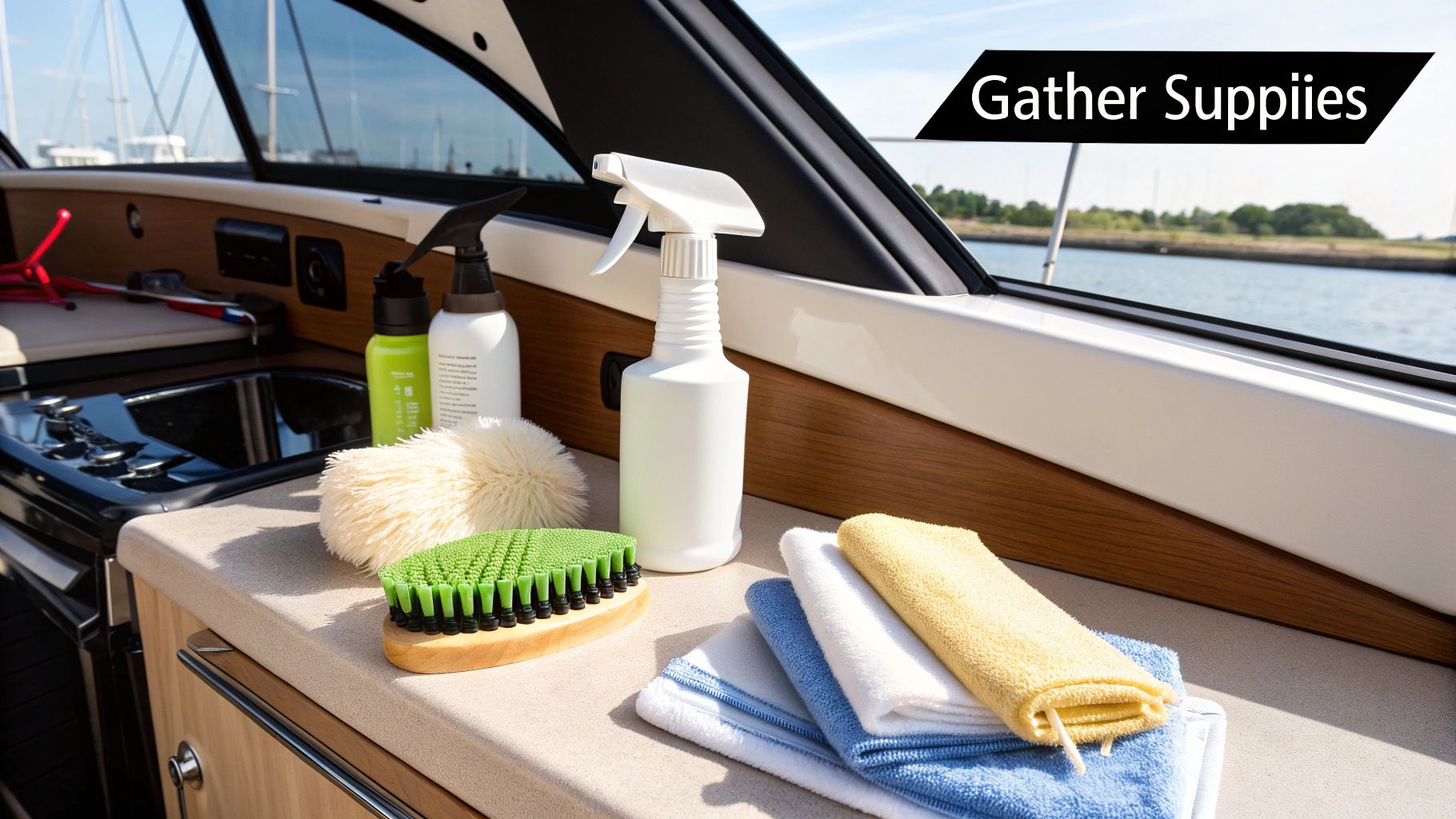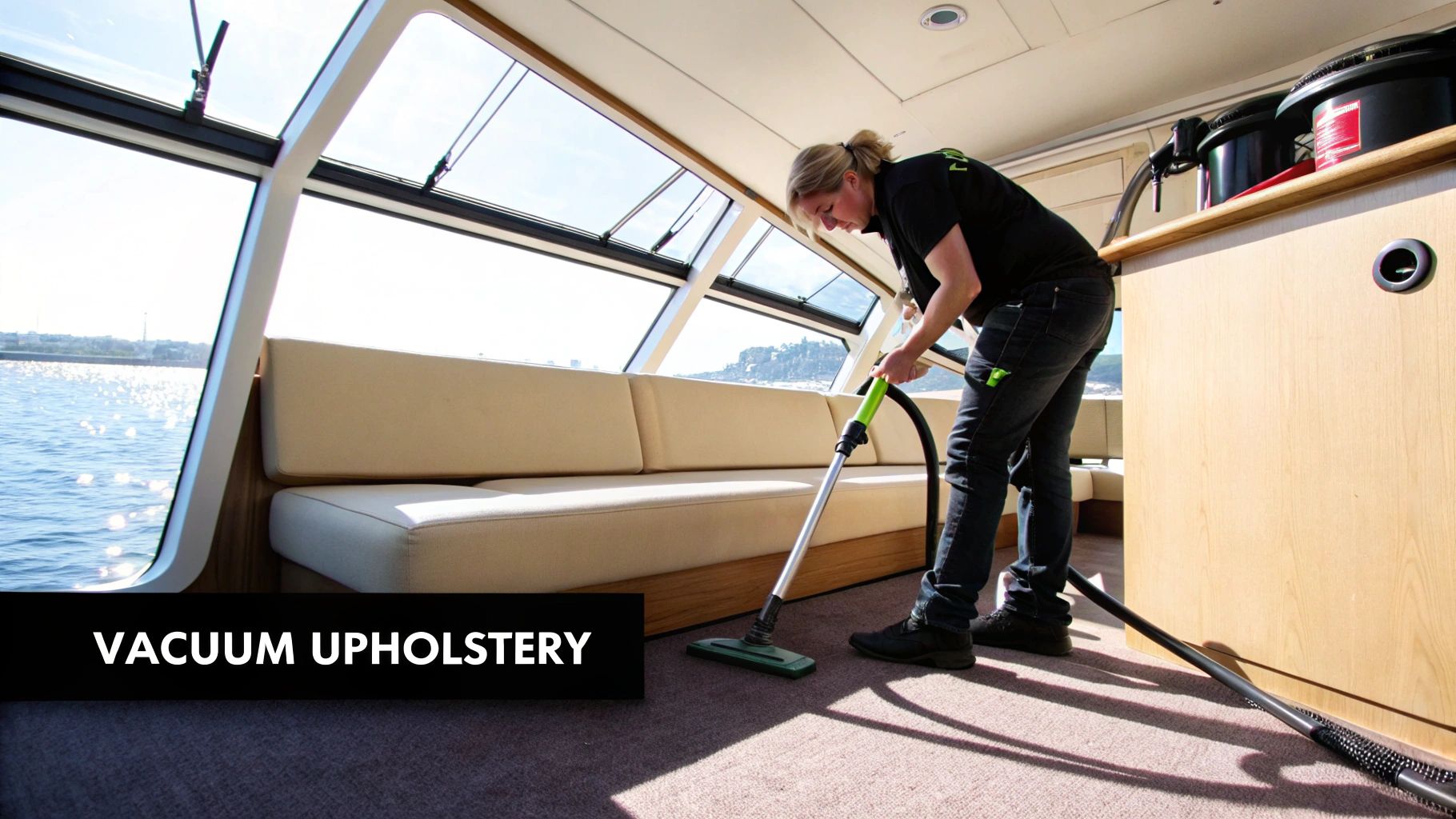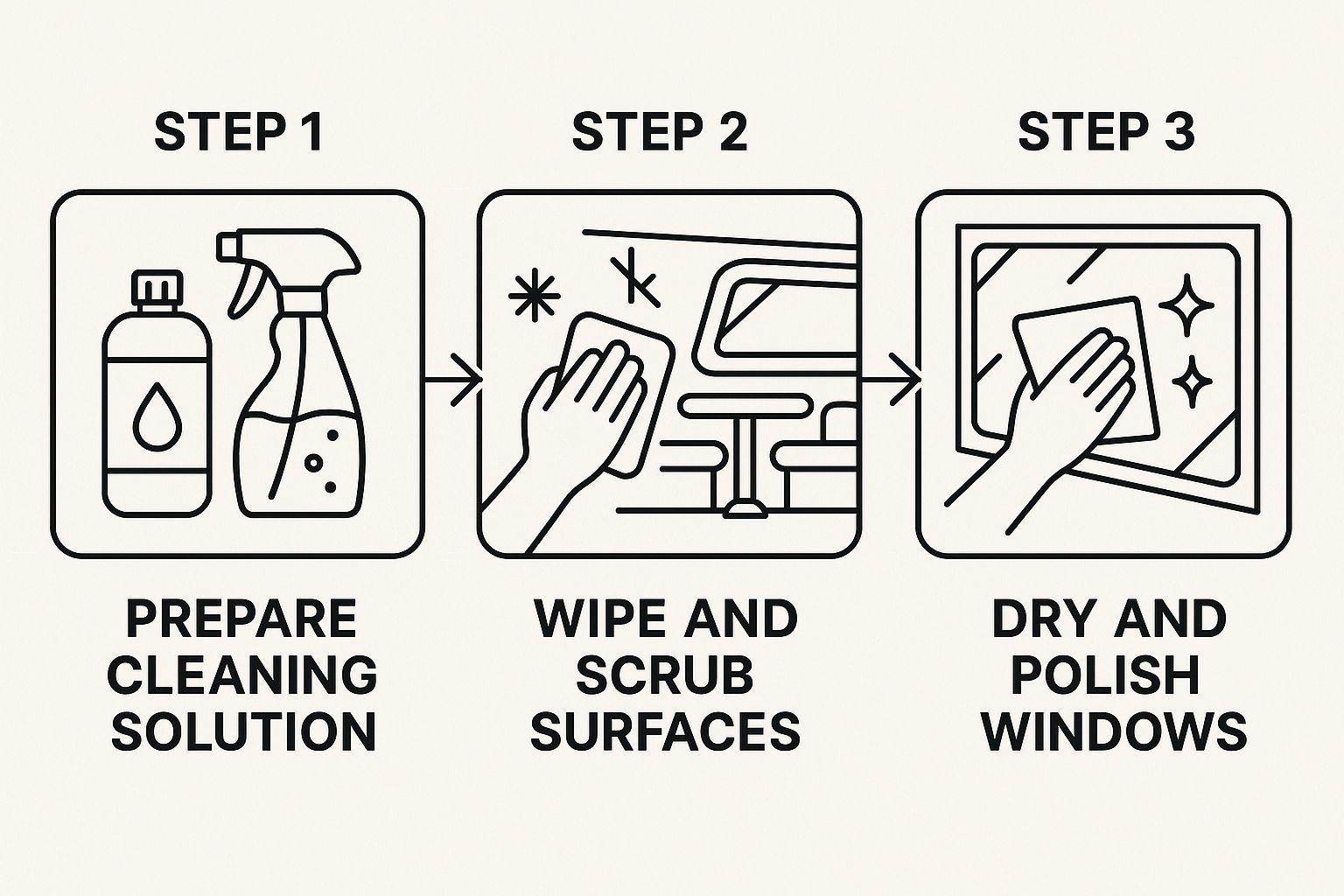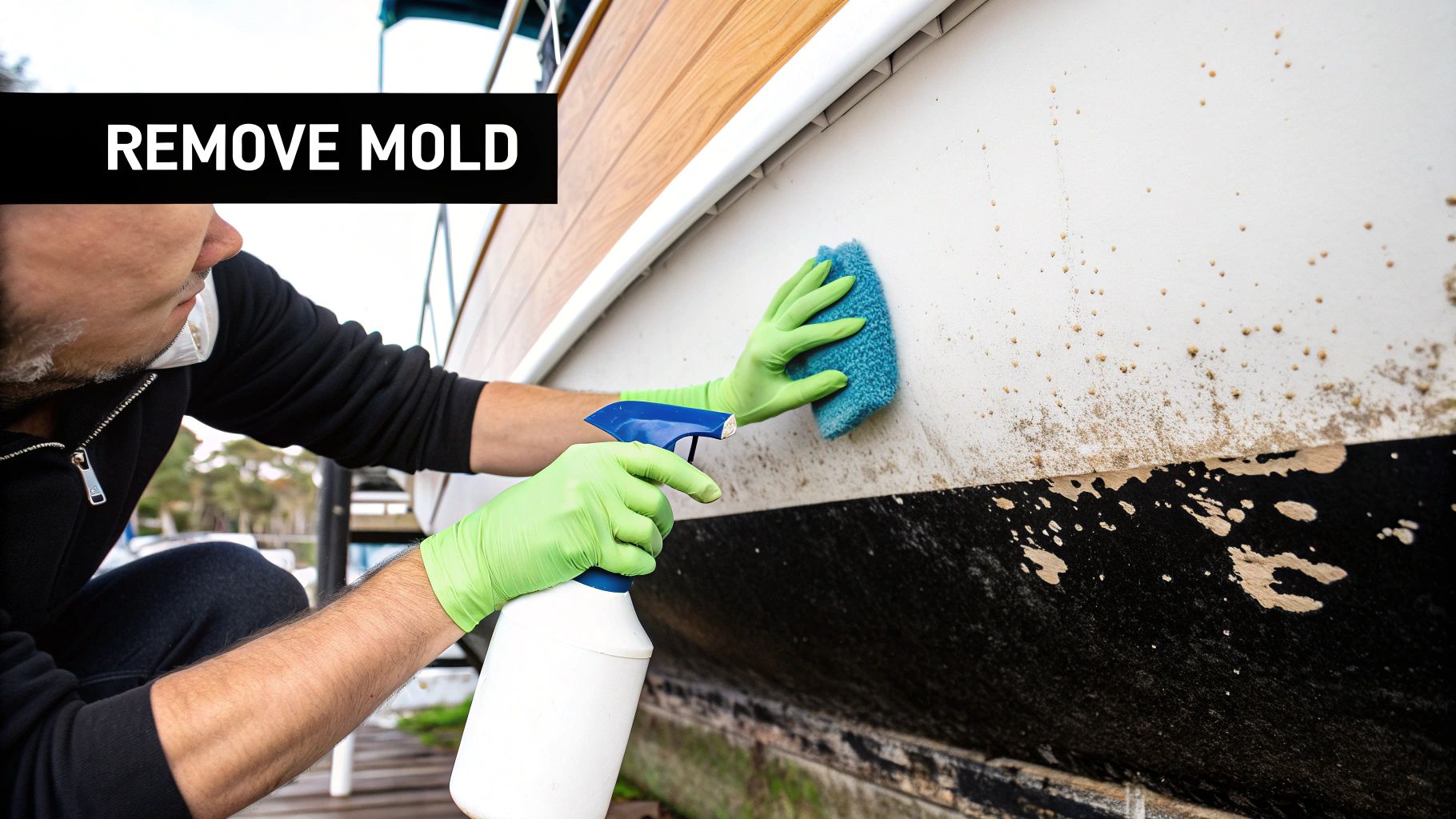How to Clean a Boat Interior Like a Pro
Before you can even think about scrubbing, you've got to prep.Learning how to clean a boat interior doesn't start with cleaners and polish; it starts with clearing the space so you can actually work. This means getting all your personal gear out of the way, running a serious vacuum over every surface, and lining up your marine-grade cleaning supplies.
Your Pre-Cleaning Game Plan

Jumping straight into scrubbing with everything still in the cabin is a classic rookie mistake. All you end up doing is creating more work for yourself. A methodical prep phase is the secret to a faster, more effective clean. Think of it as setting the stage before the main event.
Clear the Decks Completely
First things first: get everything that isn't bolted down out of the boat. This means all your personal items, safety gear, fishing tackle, cushions, and any other loose equipment. By creating an empty, open space, you stop yourself from just cleaning around clutter and actually get into every last corner.
This step is absolutely critical. It's amazing how much hidden dirt, grime, and potential issues you'll uncover. Plus, it keeps all your expensive gear from getting hit with cleaning chemicals by accident.
The Importance of a Thorough Vacuum
Once the interior is clear, a good, thorough vacuuming is non-negotiable. Grab a powerful shop vac with a few different attachments and hit every single surface—carpets, the crevices in the seats, inside storage lockers, and all those hard-to-reach corners. This isn't just about being tidy. You're removing the abrasive grit, sand, and dirt that will scratch surfaces or turn into a muddy mess the second you introduce liquid cleaners.
A proper vacuuming job is the foundation of a great detail. Skip this step, and you'll spend the rest of your time just pushing dirt around instead of actually cleaning.
Assemble Your Cleaning Arsenal
With a clean, empty slate, it’s time to gather your tools. Having everything you need within arm's reach before you start means no stopping and starting. It just keeps the whole process flowing smoothly. For the unique challenges of a marine environment, a well-stocked kit is a must. We actually put together a full guide on building the perfect boat cleaning kit to make it easy.
At a minimum, your checklist should include:
- Soft-bristle brushes for vinyl and upholstery.
- Microfiber towels for wiping down surfaces and drying.
- Marine-grade cleaners specifically for vinyl, fabric, and carpet.
- A bucket and fresh water.
Restoring Vinyl and Hard Surfaces

Your boat's vinyl seats and dashboards take a beating. They’re constantly under assault from sun, salt, and layers of sunscreen. If you let it go, you end up with that chalky, faded look that makes a boat look years older than it really is. Bringing them back to life takes more than a quick wipe-down; you need the right approach to restore the finish without causing more damage.
First things first, grab a dedicated cleaner made for marine vinyl, like Better Boat's Vinyl Cleaner. The trick is to work in small, manageable sections so you can stay on top of it. Spray the cleaner directly onto a section and just let it sit for a minute. This gives it time to start breaking down the grime, especially those stubborn sunscreen stains and mildew spots.
The Right Way to Scrub
Once the cleaner has had a moment to work its magic, take a soft-bristle brush and gently agitate the surface. I find that working in small circles really helps lift the dirt out of the vinyl's texture. Whatever you do, stay away from stiff brushes or abrasive scouring pads—they'll leave behind scratches and permanently damage the material.
The idea is gentle but firm pressure. You’re trying to coax the dirt out, not power-wash it away. As soon as you finish scrubbing a section, grab a fresh, damp microfiber towel and wipe it clean. This lifts away both the cleaner and all the grime it just loosened up.
This kind of careful maintenance has become a huge focus for boat owners. In fact, the market for marine cleaning products hit a valuation of $2.5 billion in 2024, with interior care products being a massive part of that. It just shows how critical proper maintenance is for preventing materials from breaking down and protecting your investment. You can find more details on the marine cleaning market on verifiedmarketreports.com.
Pro Tip: For that tough, yellowing stain sunscreen leaves behind, you might need to hit it with a second application. Patience is your best friend here. Aggressive scrubbing is the enemy of healthy vinyl.
Applying the Final Protective Shield
Cleaning is just half the battle. The most important part of the job—and honestly, the one most people skip—is applying a quality UV protectant. Once the vinyl is completely clean and dry, spray a marine-grade UV protectant onto a clean microfiber cloth and wipe it evenly over every surface you just cleaned.
Think of this final layer as a shield for your interior. It conditions the vinyl, keeping it from drying out and cracking, while also blocking the harmful sun rays that cause all that fading and damage in the first place. This simple step is the real secret to keeping your boat's interior looking brand new, season after season.
Deep Cleaning Boat Upholstery and Fabrics
Fabric cushions, curtains, and berth mattresses are magnets for moisture. If you're not careful, they can quickly lead to musty smells and even mildew growth. Taking care of your boat's fabrics is a huge part of learning how to clean a boat interior properly, and it's a whole different ballgame than just wiping down vinyl or fiberglass. You've got to know when a quick spot treatment will do and when it's time for a full-on deep clean.
For those everyday spills—a dropped snack or a splash of coffee—acting fast is everything. Grab a clean, absorbent cloth and blot the area right away. Whatever you do, don't rub. Rubbing just grinds the stain deeper into the fibers. A good marine fabric cleaner, like Better Boat's Fabric Cleaner, is your best friend for these targeted clean-ups.
Performing a Full Fabric Refresh
When it's time for a more serious cleaning, like at the start or end of the season, you'll need to dig a little deeper. If your cushion covers are removable, your best bet is always to take them off. Check the care labels first—some might even be machine washable on a gentle cycle with a mild detergent.
Before you go spraying cleaner all over everything, always do a quick colorfastness test. Find a hidden spot, maybe the underside of a cushion or an inside seam. Apply a small amount of cleaner, let it sit for a couple of minutes, then blot it with a clean white cloth. If you don't see any color transfer, you're cleared for takeoff.
A common mistake I see all the time is oversaturating cushions with water or cleaner. The goal is to lift the dirt out, not push moisture deep into the foam. Once it's in there, it becomes a perfect breeding ground for mold and mildew, creating a much bigger headache down the road.
For tougher stains like fish blood or mildew, you might need to bring in a specialized stain remover. Just follow the product instructions to the letter, using a soft brush to gently work the cleaner into the problem area. And if your seats have vinyl sections, we've got a detailed guide with specific tips on how to clean boat seats without causing any damage.
This simple infographic lays out a similar game plan for the hard surfaces in your cabin, showing the basic steps of preparing, cleaning, and finishing.

This workflow is all about being systematic to avoid redoing your work, and that same principle applies just as much to your fabrics as it does to windows and countertops.
Ensuring Everything Is Completely Dry
This part is absolutely non-negotiable: everything must get completely dry. After cleaning, prop your cushions up on their sides to get as much air circulating around them as possible. If you can, point a fan or two at the fabrics to really speed things up and guarantee no dampness is left behind. A dry interior is a fresh-smelling interior, period.
Revitalizing Marine Carpets and Flooring

Boat carpets have it rough. They’re constantly under assault from wet feet, gritty sand, spilled drinks, and the occasional fish scale. Bringing them back from the brink requires a bit more muscle than your typical house vacuuming.
Grab a shop vac and get to work. The crevice tool is your best friend for getting deep into the edges where grime loves to hide. For the high-traffic areas, use a stiff brush attachment to really agitate the fibers and pull out that stubborn, embedded dirt.
With the loose stuff gone, it’s time to attack the ground-in filth. A dedicated marine carpet cleaner is a must-have here, as it's formulated to break down salt and mildew. For a general refresh, just lightly mist the carpet and work the product in with a soft-bristle brush. If you're dealing with a nasty, set-in stain, spray the cleaner directly on it and let it sit for a few minutes before you start gently scrubbing.
Tackling Non-Carpeted Floors
When it comes to fiberglass or teak flooring, the goal is simple: clean effectively without turning your deck into a slip-n-slide.
A mild, pH-neutral boat soap mixed with some fresh water is all you need. Mop the floor, but here’s the key—immediately follow up with a dry microfiber mop or a few towels. This prevents those dangerous slick spots from forming. Whatever you do, avoid using wax or polish on these walking surfaces.
It's no surprise that the boat cleaner market is booming, with projections expecting it to hit around $500 million by 2025. This just goes to show how critical good interior cleaning is for fighting off common boat problems like mold and nasty odors. You can dig deeper into these numbers in this boat cleaner industry report.
If you take away one thing, let it be this: the final and most critical step for any flooring is ensuring it is 100% dry. Use fans, crack open hatches for ventilation, or even run a small dehumidifier. Trapped moisture is the number one enemy and the primary cause of that all-too-familiar musty boat smell.
Seriously, never close up the cabin until the floor is completely bone-dry to the touch. Making this a habit is the secret to keeping your boat's interior smelling fresh and clean all season long.
Final Touches and Long-Term Protection
You've done the heavy lifting, but it's the final details that take your boat's interior from just "clean" to truly pristine. A perfect example? Getting those windows and portholes to sparkle. The secret here is a dedicated glass cleaner and two microfiber towels—one for cleaning and a fresh, dry one for buffing. It’s the only way to get that streak-free finish that really lets the light pour in.
With everything cleaned, it's time to shift gears from reactive cleaning to proactive protection. This isn't just an extra step; it's how you lock in all your hard work. Think of it as applying a protective topcoat to your entire interior.
Shielding Your Surfaces
Applying the right protectants is like putting up an invisible barrier against future messes. For all your vinyl seats, dashboards, and trim, a quality marine UV protectant is absolutely non-negotiable. It does double duty: conditioning the material to keep it from cracking while also blocking the sun’s harsh, damaging rays.
For fabrics and carpets, a marine fabric guard is a total game-changer. It helps spills bead up instead of soaking in, which makes future cleanups a breeze and stops stains before they even have a chance to set. This kind of proactive care is what modern boat maintenance is all about.
Maintaining boat interiors with specific products is crucial for prolonging material life and preserving resale value, which is why interior cleaning is such a steadily growing segment in the boat cleaner market. Learn more about these boat cleaner market trends.
This small investment of time now pays off big time by keeping everything looking new for longer. For a deeper dive into picking the right products, check out our complete guide to choosing a boat interior cleaner and protectant.
Finally, get into a few simple habits for ongoing upkeep. Tuck some moisture-absorbing canisters in lockers and other enclosed spaces to fight off those musty smells. After each trip, give the high-traffic areas a quick wipe-down. This consistent, low-effort routine is the real key to making sure your boat is always guest-ready and protected for the long haul.
Common Questions About Boat Interior Cleaning
Even the most seasoned boaters run into questions when it's time to deep clean the interior. It's just part of the deal. We've put together some of the most common ones we hear from our community to give you some quick, no-nonsense answers.
Think of this as your quick-reference guide for those moments when you're staring at a stain and wondering, "Now what?"
How Often Should I Deep Clean My Boat?
For most boat owners, a full-on, deep clean at the beginning and end of the season is the sweet spot. This gets you ready for the water and puts your boat to bed the right way for the off-season.
Now, if you're out there every weekend or live where the humidity is always sky-high, you'll want to do a more focused clean monthly. Hitting those high-traffic areas will make a world of difference. The real game-changer, though, is the simple wipe-down after each trip. It makes those big seasonal cleans so much less of a headache.
That funky "boat smell"? That's almost always mildew caused by trapped moisture. Before you even think about cleaning, your first job is to hunt down and fix any leaks. After everything is clean, get it completely dry with fans, a dehumidifier, or just good old-fashioned airflow.
To keep things fresh between outings, toss a few moisture-absorbing canisters or charcoal bags in your lockers and under the cushions. They're surprisingly effective at pulling that dampness right out of the air.
Can I Use Household Cleaners?
I know it's tempting to just grab the bottle of cleaner from under your kitchen sink, but please don't. This is one of the biggest mistakes we see people make, and it can cause irreversible damage.
Most household products are packed with harsh chemicals like bleach or ammonia that are brutal on marine-grade materials.
- They'll make your vinyl brittle and cause it to crack over time.
- They can strip the color right out of your upholstery.
- The chemicals literally eat away at the stitching, weakening your seams.
- They remove the UV protective coatings that are essential for preventing sun damage.
Always, always use products that are actually made for boats. They're formulated to tackle the tough marine environment without destroying your interior in the process.
How Do I Remove Stubborn Mildew Stains?
For those nasty, set-in black mildew spots on vinyl seats, you need to bring in the big guns: a dedicated marine mold and mildew remover. Apply it right on the stain and give it a few minutes to do its thing (check the label for specific times).
Next, grab a soft-bristle brush and gently scrub the area before wiping it clean with a fresh, damp cloth. Don't be surprised if a really stubborn stain needs a second round. The final, and most important, step is to follow up with a quality UV protectant spray. This isn't just for shine; it creates a barrier that helps stop that mildew from coming right back.
Ready to tackle every surface with confidence? The complete line of marine-grade cleaners and protectants from Better Boat is designed to make the job easier and deliver professional results. Explore our cleaning products today!


